Its popularity may have been short-lived, but for a brief period during the mid-sixties Batman was even bigger than The Beatles!
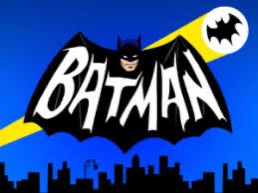
Like The Beatles, it’s difficult to understand just what a phenomenon the 1960s TV series Batman actually was. If you were a child between the ages of 5 and 15, for a couple of years, and it was only a couple of years, this TV programme dominated your life. If you were a sophisticated adult you’d have loved the campness and archness of the script. To watch it today brings back just how funny, enjoyable and often downright surreal so many of the episodes were. Its charm and inventiveness has not diminished, it has influenced a range of other TV programmes over the years and has been parodied regularly. Not least in sophisticated TV series of the last few years including The Simpsons, Futurama, Spongebob Squarepants, Family Guy and even Only Fools and Horses.
Nothing like it had ever been seen on TV in 1966. Not only was it a character who everyone knew through reading American comics but this was a high quality production that used eye-catching special effects (for the time), had memorable music that people still remember today (Da-da-da-da-da-da-da-da, da-da-da-da-da -da-da-da, Bat-maaan!), where every episode was a roller-coaster ride and weird characters abounded. What wasn’t to like? It seemed to be really funny but why were Batman and Robin taking it so seriously? We know now that this was the essence of its brilliance. And some of the Special Guest Villains were certainly strangely creepy, occasionally threatening and the casting was often wonderfully bizarre. Not forgetting the trademark fight sequences with their pop-art onomatopoeic graphics (Pow! Blam! Splat!).
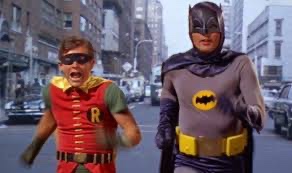
As a five-year old when Batman was first shown on British TV in 1966 I was obsessed. Every boy of my age and older had to have a Batman or Robin outfit. They could be bought commercially but it was easier and just as effective to have your own made. My dad, who was quite good at those things, made me a Batman outfit from some black plastic tarpaulin, my pal Graham got a long bit of yellow material from his mum and instantly became Robin, The Boy Wonder, and we’d run through the streets singing ‘Da-da-da-da-da-da-da-da, da-da-da-da-da -da-da-da, Bat-maaan!’ It was so much fun. It really was.
For two years between 1966 and 1968 Batman dominated popular culture in a similar way to The Beatles. Memorablia such as character models, toy vehicles, sweets and trading cards were available and he even made some of those great favourites of Genxculture, Public Information Films. After Series 2 Batman’s star waned and we moved on to other things, probably Star Trek or Joe 90 and TV Century 21 comic as this was a massively creative decade in the media. But that period was really special and today this series looks and sounds even better than it did due to us being able to watch it in living colour which we couldn’t do then. In short, it’s still funny, satirical, brilliantly staged, wonderfully acted, endlessly inventive, featuring a who’s who of showbiz for the time and it’s still as camp as a Millet’s window display.
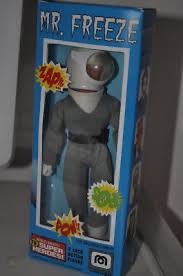
Yes, the gadgets, the cars, the weird torture machines, the fast paced narratives, the special effects, the villains all added to the excitement of the show but it was the portrayal of the central characters, Adam West’s Batman and Burt Ward’s Robin, that really lifted the series to a level rarely seen on TV up to that time. As creator, producer and narrator William Dozier said at the time, ‘It’s the only situation comedy on the air without a laugh track.’ The show was also influenced by very 60s TV series such as The Man From Uncle which wore its irony and bizarre gadgetry, sometimes literally, on its sleeve.

Three series of the show were made between January 1966 and March 1968 and although Series 3 saw a lull in its popularity, Series 1 and 2 were hugely successful. Dozier was not a fan of the American superhero comics and felt them, particularly Batman, to be unnecessarily serious and often po-faced. Hence his idea of bringing a much livelier, colourful (for a few), bizarre, fast paced and uniquely ironic TV version of The Caped Crusader.
The success of this very unusual type of show was going to be, crucially, finding the right actors to portray the heroes and villains. The great Adam West was spotted playing ‘Captain Q’ in a series of Nesquik adverts on US TV. West was attracted by the show’s ‘scrupulously formal dialogue‘ which he played completely straight from episode 1 until the end with resounding success.
Burt Ward was straight out of stage school when he landed the audition. He had the good fortune to be teamed up with the much more experienced West for the auditions and, out of 1100 audition hopefuls, his chemistry with West was obvious. TV’s Batman and Robin were born.
The producers had originally decided that the new camp Batman series would debut as a full-length feature film to introduce the characters to the great viewing public. For various reasons this didn’t happen before the series went out and the film was eventually rolled out to cinemas after the first series had concluded. For me this made Batman more exciting as, for one thing, we saw it in eye-popping colour for the first time which was a revelation to say the least. I mean, The Joker had green hair, for example! And, secondly, a new range of thrilling Bat-accessories were revealed such as the Bat-Copter, Bat-Bike and the Bat-Boat. The children’s matinee at the Tivoli cinema on Gorgie Road was certainly buzzing that Saturday afternoon in 1966!
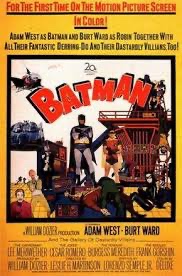
The show had many recurring elements which, for young viewers, was particularly exciting. Playing their ‘real’ identities as rich socialite Bruce Wayne and his ‘ward’ Dick Grayson, they would receive word via the ‘Batphone‘ from Commissioner Gordon that some heinous crime had been committed by one of the ‘Special Guest Villains‘ and could they help? Cue the most exciting sequence in the show when they would secretly enter the bat cave through a secret passage (‘to the batpoles!) and emerge in a roaring, speeded-up Batmobile to consult with Commissioner Gordon.
Clues would be left by the villains and Batman and Robin would start to solve these bizarre clues until a final showdown punch-up (no guns were used) with the villains which would be punctuated with pop art images showing the onomatopoeic words such as Blam!, Pow!, or ‘Kapow! in flamboyant colour. Of course, that element of Batman was completely lost on our monochrome 60s telly and, apart from the Batman film which we saw at the local fleapit, it would be another 15 years before we’d see Batman in the same vivid, psychedelic colour on telly.

In between the two part episodes (shown on two different evenings of the week) Batman and Robin might find themselves in a cliff-hanger scene at the end of part one where they were invariably trapped in a situation that might lead to their deeply unpleasant demise. The narrator, William Dozier, would then chip in asking the audience if Batman will survive. ‘Tune in tomorrow! Same Bat-time, same Bat-channel!‘ Of course he’ll survive! Often due to some amazing Bat-gadget that he could just about grab from his Bat-utility belt.
The laughs came from the completely straight performances by Adam West and Burt Ward. Little gags abounded throughout the episode which you had to be quick to notice. At one point the ferociously law-abiding Batman in pursuit of a Special Guest Villain parked the Batmobile outside a large public building. As he leapt out of the driver’s seat he spotted a ‘No Parking‘ sign. Despite the imminent destruction of Gotham City he doubles back to move the car when a friendly policeman arrives and tells him, ‘That’s OK Batman,’ and rolls the sign away. The future of one of America’s great cities may be in the balance but that’s no excuse for not abiding by the law and getting a parking ticket!
The soaraway success of the series led to a range of celebrities of the time making appearances in the show. Either as ‘Special Guest Villains‘ or as themselves. One recurring sequence was when the Dynamic Duo were hauling themselves up the side of a high building with the aid of the Batrope. Of course, the camera was just turned 45 degrees to give the impression of them walking up the building, which was a joke in itself. Suddenly a window would open and a ‘famous’ person would pop their head out. To us in Scotland, many of these ‘celebrities’ were unknown given our three TV stations of the time and a limited amount of space to show many American series. But some of the celebrities were well-known including Jerry Lewis (apparently very difficult and insisting on directing and lighting himself according to Ward’s biog), the great Sammy Davis Jnr, nutty dishevelled comedienne Phylis Diller, Hollywood film gangsters George Raft and Edward G. Robinson, and one I clearly remember, Werner Klemperer in his well-known role as incompetent German POW prison commandant Colonel Klink in Hogan’s Heroes and Ted Cassidy in his role as Lurch in The Addams Family, a show which had many connections with Batman over its three year lifespan.
The most bizarre of these ‘celebrities’ popping their heads out of the window for a slightly awkward rap with the Caped Crusaders was ‘Carpet King‘ Cyril Lord. Now completely unknown by anyone under the age of 55, he was an English businessman who became well known for appearing in TV adverts for his own Cyril Lord carpet company. With the long-running booming jingle ‘These are carpets you can afford by Cyril Lord!,’ he became, like his carpets, a household name, a bit like Victor Kiam who loved the Remington company so much, he bought it. . In the TV ad jingle I always thought the name was ‘Cirr-a-lorr.’ Clearly his fame in the US was even greater.
Like Rowan and Martin’s Laugh-In which appeared shortly after Batman’s cancellation, celebrities were queuing up to appear on the show. It was even rumoured that Frank Sinatra had expressed an interest in the role of The Penguin when the show was being cast.
And talking of Batman villains.. A range of tried and tested Hollywood stars were cast as Special Guest Villains. The series began with those which appeared in the comics, or, at least, camper more outrageous versions of them, if that was possible.
The Joker: The first ever Special Guest Villain played by Cesar Romero, an actor whose biography was as long as your arm and your leg combined. He appeared in well over 100 films, most famously as The Cisco Kid in a series of 40s westerns, and pretty much every well known American TV show between the 50s and the 90s including The Man From Uncle, Rawhide, Alias Smith and Jones, Daniel Boone, Ironside, Bonanza, Dr Kildare and The Golden Girls.
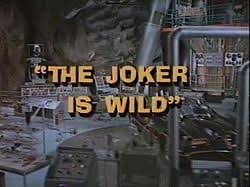
Romero appeared in 22 episodes of Batman as well as the full length film. Romero refused to shave off his trademark moustache during filming and had The Joker’s thick white makeup hide it. To me he always came across as quite a menacing character, despite the series’ camp and overblown treatment of the villains. But that was how it was meant to be.
The Penguin: Appeared in as many episodes as The Joker. I was never that keen on The Penguin. He just wasn’t evil enough. Played by Hollywood stalwart Burgess Meredith, he wasn’t the first choice for the role. The producers of Batman wanted Spencer Tracy as The Penguin which would have been very interesting indeed. A bit like when the producers of Columbo originally wanted Bing Crosby to play the eponymous role. However, he said he’d only do it if he could kill Batman, and that wasn’t going happen. Maybe he only said this to wriggle out of the part but, after its incredible success and popularity, I wonder if he regretted it?
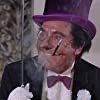
Non-smoker Meredith developed The Penguin’s squawk as a way of not having to inhale the smoke from his ever-present cigarette holder.
The success of Batman, even spilled over into another hugely successful series of the mid-60s when Meredith appeared as The Penguin in an episode of The Monkees (See Hey, Hey It’s the Monkees!).
Catwoman: The most frequent Special Guest Villain, appearing 15 times over the three series. Originally played by newcomer Julie Newmar who, for the first two series, the sexual chemistry with Batman added an extra frisson to their scenes together. Was she really attracted or was she merely using her not inconsiderable feline charms to entrap him? You decide. But one could understand why Batman’s super powers of restraint were severely tested.

For the third series Newmar, who was filming McKenna’s Gold at the time, was replaced by the legendary Eartha Kitt in, for the time, an audacious bit of casting for ultra-conservative America. Of course, this meant the chemistry between them changed as the idea of Batman being romantically linked with black woman was a bridge too far for the producers in a 60s US not exactly embracing multiculturalism. That said, this sort of intimate relationship was only a couple of years away with Kirk and Uhura in Star Trek. But it was still, almost unbelievably, a big deal on mainstream US TV.
For the film version which should have been released before the TV series but wasn’t, Catwoman was played by Lee Merriwether, who some still remember as the original Catwoman, even though she never appeared in the TV series.
Kitt’s ability to purr her lines and generally behave in a feline sort of way came naturally to her, she was perfect (I refuse to say ‘purr-fect’) for the character and her car had to be seen to be believed. Catwoman was one of my favourite villains and she still is……

The Riddler: Played by American impressionist and comedian Frank Gorshin, a huge star in the US but not very well known in the UK at the time. I have a vague memory of him appearing on a British variety show during the 60s. I don’t think he went down that well as his impressions were all of American celebrities and we were used to Mike Yarwood doing Harold Wilson and Ted Heath, so his repertoire left British audiences fairly cold. On further research the good people at IMDB seem to think it was The Dave Allen Show in 1969. This would be after Batman ended its three series run, however. He appeared on pretty much every American variety show including the Jerry Lewis, Andy Williams, Sammy Davis Jnr and Dean Martin shows. He also appeared on The Danny Kay Show in 1966 which we definitely did get in the UK, which may have gone out before Batman hit our British screens. Either way I distinctly remember seeing Frank Gorshin do his impressionism act before I’d seen him as The Riddler.
Another interesting fact about Frank Gorshin (well, I think it’s interesting..) is that he appeared on the same Ed Sullivan Show as The Beatles when they made their US debut in 1964. Craig Brown in his brilliant new book on The Beatles, One, Two, Three, Four, includes a superb chapter told from the viewpoint of some of the other guests on the show that day of 9th February 1964. It’s also hard to believe that ‘two-ton’ Tessie O’Shea also appeared, as did the Broadway cast of Oliver! including British performer Georgia Brown and a young cast member named Davy Jones (see Hey, Hey It’s the Monkees!). Wonder whatever happened to him? Maybe with all these British performers, Ed Sullivan thought The Beatles might feel at home.

He appeared in 9 episodes of Batman which I found surprising as he seemed to be involved much more often. He didn’t appear at all during series 2 as some have claimed he was sidelined by the producers for making unrealistic wage demands. His role was taken for one episode by The Addam’s Family’s John Astin. However, he returned to the fold for one last episode of the third series in 1967.
Cool, Cruel Mr Freeze: With three different, very interesting and unusual actors playing this villainous part, Mr Freeze appeared in all three series of Batman.
First up was a typically left-field choice, suave and prolific Hollywood actor George Sanders. Sounding every inch the superior and upper crust, often quietly menacing, English cad, Sanders was actually born in Russia and moved to England with his family at the outbreak of The Russian Revolution in 1917.
He ended up in Hollywood in the 1930s playing a pre-Roger Moore Simon Templar in a series of US-made The Saint films. His other notable roles included playing dodgy aristocrats in Hitchcock’s Rebecca, Addison De Witt in All About Eve, for which he won an Oscar and Roberto Rossellini’s neo-realist classic, Journey To Italy with Ingrid Bergman. The role he is best remembered for though, is voicing tiger Shere Khan in Disney’s classic The Jungle Book.
In true Hollywood style he married four times, weirdly two of them being Gabor sisters, Zsa Zsa and Magda (the latter lasting only 32 days). His voice and manner inspired Peter Sellers to base the character of Hercules Grytpype-Thynne on in The Goon Show. In 1958 he released an album of songs, some composed by him with the wonderful title, The George Sanders Touch: Songs For The Lovely Lady. I really would love to hear that sometime.

Sanders died of an overdose of barbiturates in 1972 in a village near Barcelona. His suicide note did not dwell on disappointment but just stated he was bored with life and had had enough. His role as Mr Freeze could not have suited him more.
An even stranger choice to take over from Sanders and one that couldn’t have been more different was legendary Hollywood director Otto Preminger. Although achieving world-wide acclaim as a director of classics such as Laura, The Man With The Golden Arm and the excellent British Film Noir, Bunny Lake Is Missing, he had done some acting, mainly during the 40s and 50s. His most well known role being as Oberst von Scherbach in Stalag 17, directed by Billy Wilder. According to Preminger he’d never heard of Batman but his grandchildren persuaded him to ask for a part. Apparently Preminger knew producer William Dozier and asked to be cast. However, Preminger couldn’t adapt to the idea of being an actor rather than a director and rubbed many of the cast members up the wrong way by shouting at them to ‘concentrate’ if they fluffed their lines. He was frozen out (ho ho) and wasn’t invited back in series 3 to play Mr Freeze again. Once a director, always a director!
The next and last Mr Freeze was another legendary Hollywood actor, ‘method’ actor supreme Eli Wallach.

Egghead: Played by ubiquitous Hollywood actor, the excellent Vincent Price (much more on him dotted around this little blog space), he was the self-styled World’s Smartest Criminal. So much so he was one of only two Batman Guest Villains who worked out Batman’s real identity. His weapons of choice were always in the form of eggs, the most memorable being the Tear-Gas Eggs laid by hens fed exclusively on onions.
Chandell: played by, of all people, Liberace! He was probably the most well known of all the Special Guest Villains and not only did he play the villain, Chandell, a cute little reference to one of his trademarks, the chandelier, but he also played his even more crooked brother in some groundbreaking split-scene photography. But in one of his final scenes we see him in jail wearing prison stripes as does his grand piano. A superbly subtle and funny Batman touch!
Liberace went on to appear in many cult series of the 60s and 70s including Rowan and Martin’s Laugh-In, Kojak and The Muppets. And in The Monkees he even smashes a grand piano.
Liberace’s life was arguably so full of excess, intrigue, and hyperbole that nothing he did professionally was as overblown as his private life. And, in Batman, he found a role that suited his larger-than-life profile. To be honest I don’t have a particularly clear memory of Liberace’s appearances on Batman at the time but on viewing some of them today, he was perfect for the show. There may be more to come on Liberace within his little blog space in the near future……


King Tut: Played by Hollywood actor Victor Buono, King Tut appeared in eight episodes of Batman over the whole three series, Only Joker, Riddler, Catwoman and Penguin appeared more often. Playing a mild-mannered professor of Egyptology who turns into the evil King Tut when he receives a bump on the head, it’s hard to believe Buono was only 28 when he played the role.
A stalwart of many films and cult 60s telly, Buono also appeared in Voyage To The Bottom of the Sea, The Man From UNCLE, I Spy and even The Flying Nun. For me, though, King Tut wasn’t weird, evil or threatening enough to be an acceptable Batman villain and the episodes involving him are only sketchy in my memory. Like Egghead, King Tut was the only other villain to guess Batman’s identity but, luckily for the Caped Crusader, another blow to the head made him forget by the end of the episode.

Many other Special Guest Villains appeared in Batman, some memorable like The Archer and The Minstrel, played by Hollywood actors Art Carney and Van Johnson. Other members of Hollywood royalty queued up to play villains on Batman. Some scarcely remembered such Minerva (Zsa Zsa Gabor), Clock King (Walter Slezak), Lola Lasagne (the formidable Ethel Merman) and Louie The Lilac (Milton Berle). The British acting contingent was represented by Joan Collins as The Siren, one of the last Special Guest Villains in series 3, Maurice Evans was The Puzzler, he would soon play a career defining role as Dr Zaius in one of the greatest science fiction films ever made, Planet Of The Apes as well as Samantha’s father in Bewitched. A fellow-simian colleague of Evans from Planet of the Apes was Roddy MacDowall who played Bookworm in Series 3. The Sandman played by Michael Rennie, who also played Harry Lime in the long-running US TV series of the 60s The Third Man as well Klaatu in the 50’s cold war classic The Day The Earth Stood Still. But it was a case of too much, too late for Batman and the third series proved to be the last. Another network eventually decided to take over the franchise but by that time the expensive sets had been demolished and it didn’t happen.
One interesting guest who was not a Special Guest Villain was a certain Jay Sebring. Sebring was a fashionable Hollywood hairdresser who appeared in a Catwoman episode on December 15 1966 during Series 2 where he was billed as Mr Oceanbring (geddit?). On the night of August 9 1969 he would be one of the five victims of the Manson family at the Cielo Drive home of Sharon Tate and Roman Polanski in the Hollywood hills.

Batman’s massive popularity in the UK even led to Adam West making a Public Information Film in the UK showing children how to cross the road safely. For some reason the producers of these films always seem to think a famous person would hammer the point home more effectively. Maybe they were right but when you think of the many other ‘celebrities’ who, over the years, also helped children across the road it does make you wonder. Recently departed Dave Prowse (Darth Vader) as ‘Green Cross Man,’ Alvin Stardust (You must out of your tiny minds.…), Les Gray of Mud, Boxer Joe Bugner, footballer Kevin Keegan and John ‘Dr Who‘ Pertwee with his frankly baffling ‘SPLINK’ campaign. Out of that lot I’d listen to Batman every time. He’s more believable.
Another campaign that Batman and Robin got behind, that few will remember, involved children launching themselves out of high buildings. Or so we were led to believe by some tabloid newspapers. Whenever something takes off (wrong description maybe!) like Batman did in 1966, people look for the downside of the fandom and phenomenon. According to some newspapers, children, believing Batman could fly, were emulating him by jumping out of high windows, although I don’t remember a single specific incident of this type being reported. Any young child, like myself at the time, would have known full well that Batman, unlike Superman, could not fly. They’d watch the TV programme, read the comics or talk to other Batman fans. Another example of the media wrongly believing children to be stupid. Anyway, Batman was asked to nip this supposed pernicious behaviour in the bud. And at the end of certain episodes a short insert was tagged on. Batman and Robin would speak directly to their young viewing public and remind them that Batman could not fly.
As with any phenomenon, irrespective of how short-lived, the spin-off memorabilia was huge. For a while everything was Batman related. Action figures, sweets, outfits, toy cars, posters and sundry other memorabilia were everywhere.
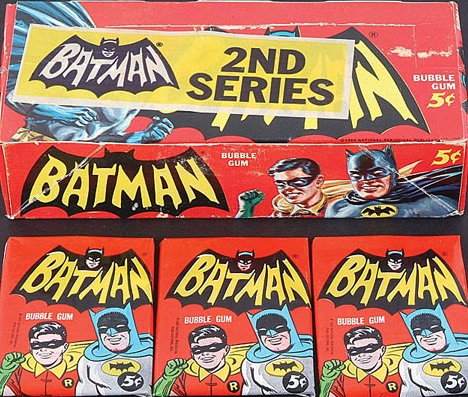
My own personal favourite out of all this Batman-related tat were the trading cards which were released in 1966. Three different versions (black, red and blue symbols) were available, each with either a description of the scene depicted or part of a larger puzzle on the back which could be constructed when all the relevant cards had been collected. The cards showed scenes which included Batman’s most prolific foes such as The Joker, The Riddler, Catwoman and The Penguin as well as a few newly created adversaries such as the supernatural Jack Frost and even some dinosaurs. The lack of authenticity of some of the cards to the TV series certainly didn’t put us off collecting all three series. Some of the cards also depicted scenes from the TV series. Although essential collecting for the 6/7/8 year old, I don’t quite remember the same frisson of excitement one felt when collecting the Civil War News or Battle cards of a couple of years previously. (See AieeAiiieee! The Blood-Soaked Realm Of 60s Children’s Trading Cards below). By the time the cards became available, Batman’s popularity was on the wane slightly.








Like all, mainly male, 7 year olds in 1966 I received a toy Batmobile for my Christmas. Unlike much Bat-related merchandise of the time, Batmobiles were high quality, sturdy items made of metal. When you rolled them along the ground orange plastic flames emerged from the back exhaust of the vehicle, small cannons at the back could launch missiles (which you’d lost by Christmas afternoon) and a metal cutting tool (I think that’s what it was, I was never that sure) which could be pulled out on the front bonnet. Like James Bond‘s car, the Aston Martin DB5 which was popular around the same time, these toys are worth a small fortune now and, of course, I have no idea what happened to mine.

To be honest, I’d lost some interest by the time series 3 came along. There seemed to be a plethora of strange and sometimes not very engaging characters and it didn’t seem the same when The Joker, The Riddler, The Penguin and Catwoman were not involved. I think I now appreciate these episodes more as an adult but this wonderful highly stylised, highly camp treatment of Batman maybe had a relatively short shelf-life, like a very expensive, flamboyant meal. The first few courses would be amazing but eventually you’d have had enough. But for a couple of years in the mid-60s Batman was a hugely important element of the zeitgeist and Adam West and Burt Ward’s brilliant portrayal of the Dynamic Duo as well as the over-the-top characters made it essential viewing.
So if you want an excursion that is still as cool, camp and clever now as it was all those years ago, you know where to go.
Same Bat-time, same Bat-channel…
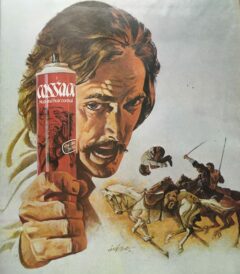
[…] Batman: A 60s Sitcom Phenomenon […]
Thanks for taking the time to write this. I’m trying to research whether or Adam West did indeed film a safety announcement asking children not to jump from windows in the UK? I can’t seem to find any anecdotal evidence of anyone who claims to have actually seen the footage. Do you remember seeing it?
I’ve looked for it too and haven’t been able to find any trace but as a child I have a very clear memory of it. It was shown straight after episodes of Batman and I think it was only broadcast a few times. The start of it was Batman and Robin talking inaudibly to each other as if deciding what they were going to say. They then pointed at each other as if to say ‘Go for it.’ Adam West then turned to camera and began by saying ‘Batman CANNOT fly so…… To me it just seemed stupid as even as children we knew he couldn’t fly and we certainly would not jump out of high buildings! I’m not sure if it was an American or British safety announcement but I suspect the former. Definitely a bit of media hysteria.